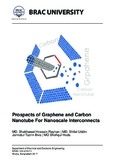| dc.contributor.advisor | Haque, Anamul | |
| dc.contributor.author | Rayhan, Md. Shakhawat Hossain | |
| dc.contributor.author | Uddin, Md. Shifat | |
| dc.contributor.author | Biva, Jannatul Tazrin | |
| dc.contributor.author | Huda, Md. Shofiqul | |
| dc.date.accessioned | 2018-01-22T05:38:41Z | |
| dc.date.available | 2018-01-22T05:38:41Z | |
| dc.date.copyright | 2017 | |
| dc.date.issued | 2017-12 | |
| dc.identifier.other | ID 13121089 | |
| dc.identifier.other | ID 14121015 | |
| dc.identifier.other | ID 14121010 | |
| dc.identifier.other | ID 14121001 | |
| dc.identifier.uri | http://hdl.handle.net/10361/9126 | |
| dc.description | This thesis report is submitted in partial fulfilment of the requirements for the degree of Bachelor of Science in Electrical and Electronic Engineering, 2017. | en_US |
| dc.description | Cataloged from PDF version of thesis. | |
| dc.description | Includes bibliographical references (page 53-60). | |
| dc.description.abstract | Interconnects are the channels that provide power and carry signals between various
components on an integrated circuit. As technology is shrinking to nano scale the
thickness of the interconnect wire is also decreasing. Currently, copper (Cu) is
being used as interconnect material but with the scaling in nanometer regime, it
exhibits much difficulties in terms of IC performance and reliability. Which is the
bottleneck for improving IC performance in future. When the thickness of the
copper wire reduces to 41nm its resistivity becomes approximately 1.5 times of the
bulk resistivity[56]. When this thickness is 10nm the resistivity is infinite. Not only
this to keep pace with the current technology node of interconnets a large amount
of current has to flow within a very thick wire. for this reason the wire has to
withstand with a high current density. But copper at nanometer range only sustain
in 106A/cm2[81] of current densities with some structural defects. Also in this
current density copper wire exhibits very high joule heating consequently degrades
the IC’s performance. Progressively high curent density leads to electromigration
faliure which degrades wire life time. As a result IC lose its longevity. To tackle this
challenges and difficulties faced by copper wires it is high time to think of another
material which can be used as interconnect for future devices. The new material have
to have sustainability in nanoscale with higher breakdown current density, Elecromigration
antagonist and joule heating preventive which leads to high performance
IC’s. Also the new material need to be reliable which makes the interconnect lifetime
higher. In this paper we are proposing two new material named graphene and carbon
nanotube(CNT) which can be the effective replacement of copper. Graphene and
CNT can be implemented in nanoscale interonnects for their magical characteristics.
Both of this material have nanoscale physical configuaration. Graphene has low
resistivity (1u
cm)[72] is even lower compared to other good conductor like silver
(1.5u
cm). Not only this CNT’s and Graphene can withstand current densities
up to 109A/cm2[81] which make them electromigration antagonist. But The only
challenge for graphene is schottkey barrier it creates at the junction of the metal and
semiconductor which causes a barrier height for electron to pass through. Another
compound mixing where the barrier height is less can solve the problem of graphene.
If this issue is resolved, we may then directly use Graphene and CNT for nano
scale interconnects. This paper extensively illustrates why Graphene and CNT
can be the best alternative for replacing copper. In the beginning of the paper
different kinds of interconnect has been described. Later that the paper delivers
a comprehensive review of the previous, existing materials used for interconnects
v
and then described the new materials for interconnects. The paper also elaborates
the major limitations of copper in nanoscale interconnects and then successfully
delineate the major advantages we may get from graphene and carbon nanotube
as interconnect material. After that the production route of graphene has been
described. In this dissertation we tried to establish the major issues of copper and
the best alternative for that. Further study is needed for the capping material of
graphene which will increase the lifetime of the interconnect. | en_US |
| dc.description.statementofresponsibility | Md. Shakhawat Hossain Rayhan | |
| dc.description.statementofresponsibility | Md. Shifat Uddin | |
| dc.description.statementofresponsibility | Jannatul Tazrin Biva | |
| dc.description.statementofresponsibility | Md. Shofiqul Huda | |
| dc.format.extent | 60 pages | |
| dc.language.iso | en | en_US |
| dc.publisher | BRAC University | en_US |
| dc.rights | BRAC University thesis is protected by copyright. They may be viewed from this source for any purpose, but reproduction or distribution in any format is prohibited without written permission. | |
| dc.subject | Graphene | en_US |
| dc.subject | Carbon Nanotube | en_US |
| dc.subject | Nanoscale | en_US |
| dc.subject | RC delay | en_US |
| dc.subject | Electromigration | en_US |
| dc.subject | Integrated circuit | en_US |
| dc.title | Prospects of graphene and carbon nanotube for nanoscale interconnects | en_US |
| dc.type | Thesis | en_US |
| dc.contributor.department | Department of Electrical and Electronic Engineering, BRAC University | |
| dc.description.degree | B. Electrical and Electronic Engineering | |

